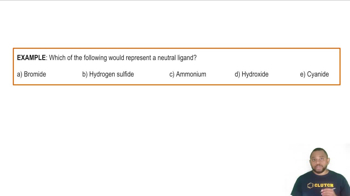What is the coordination number of the metal in each of the following complexes?
(a) AgCl2-
(b) [Cr(H2O)5Cl]2+
(c) [Co(NCS)4]2-
 Verified step by step guidance
Verified step by step guidance


What is the coordination number of the metal in each of the following complexes?
(a) AgCl2-
(b) [Cr(H2O)5Cl]2+
(c) [Co(NCS)4]2-
What is the coordination number of the metal in each of the following complexes?
(d) [ZrF8]4-
(e) [Fe(EDTA)(H2O)]-
Identify the oxidation state of the metal in each of the following compounds.
(a) Co(NH3)3(NO2)3
(b) [Ag(NH3)2]NO3
(c) K3[Cr(C2O4)2Cl2]
(d) Cs[CuCl2]
Identify the oxidation state of the metal in each of the following compounds.
(a) (NH4)3[RhCl6]
(b) [Cr(NH3)4(SCN)2]Br
(c) [Cu(en)2]SO4
(d) Na2[Mn(EDTA)]
What is the formula, including the charge, for each of the following complexes?
(a) An iridium(III) complex with three ammonia and three chloride ligands
(b) A chromium(III) complex with two water and two oxalate ligands
(c) A platinum(IV) complex with two ethylenediamine and two thiocyanate ligands